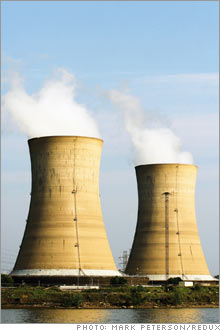(Fortune) -- Ralph DeSantis was home in bed before dawn on March 28, 1979 when his phone rang. It was his shift supervisor at Three Mile Island (TMI), calling from the plant. "'We have an emergency at Unit II and it's serious,'" is the first thing DeSantis remembers hearing. Then he heard the alarms going off.
Twenty-eight years after the worst accident in the history of the US nuclear power industry, the alarms are still going off, and the consequences are still being felt. That's why I made TMI one of my first stops on a two-week, 7,000-mile road trip through the past, present and future of nuclear power in America.
 |
| The accident at Unit 2 gave the industry a bad name, but Unit 1 still runs smoothly. |
The industry is gearing up to build its first new plants in decades.
How bad was the accident really?
The industry is coming alive in the Midwest's Ohio Valley.
Will power companies foot the bill?
It's not easy building a home for spent radioactive material.
An Idaho lab is at work on next generation reactors that promise to deliver more reliable energy.
DeSantis showed me around. He still works at TMI, although his job has changed. He used to be a security guard. Now he's a flack, a function which - and this is hard to believe - did not exist at Three Mile Island before the accident.
Somebody had to manage the crush of reporters, DeSantis stepped in, and that's what he's been doing ever since. So there's one small consequence of TMI: a new career for DeSantis, not to mention greatly expanded job opportunities for flacks throughout the industry.
TMI also confirmed a lot of people's worst fears about nuclear power, including, I'll admit, my own. I never really examined those fears again until recently, and I don't think I'm alone in that regard. After TMI, nuclear power sort of fell off the radar in the United States. Whatever your feelings 30 years ago, chances are you still feel the same way.
Impact on health
I think the question we need to ask ourselves now is pretty simple: Is it time to take a fresh look at nuclear power? One of the experts I talked to before I began my trip was Andy Kadak, a professor in the top-ranked nuclear engineering department at MIT. I asked Kadak, What were the health consequences of TMI? "Nothing," he insisted, "Practically speaking, nothing."
Then he addressed Chernobyl. "That was a worst-case scenario. Ten kilometers were significantly affected, but were cleaned up. Thirty kilometers were made into a restricted zone, but now people are coming back, rightly or wrongly. There was radiation distributed around the world - but it was probably less than what was emitted by nuclear weapons testing back in the '50s or '60s. It was clearly unacceptable.
"But I don't think it gets any worse than that. You had a burning fire throwing up this radioactive debris and distributing it all over the planet. It doesn't get worse than that." Kadak's conclusion: "Even in the worst-case scenarios it's very hard to see a global nuclear nightmare occurring because of a nuclear accident."
Putting things in perspective
Kadak and others led me to James Lovelock's fascinating book, "The Revenge of Gaia." Lovelock is a British environmental scientist who has come to the hard conclusion that the unprecedented challenge of global warming leaves us no choice but to make a massive global investment in nuclear power, which emits no greenhouse gasses.
Are there safety risks associated with that? Well, sure, but here's how Lovelock puts those risks in perspective.
How many people died at TMI, Lovelock asks? Zero. How many at Chernobyl? According to an authoritative study conducted by the United Nation's World Health Organization 19 years after the accident, no more than 75 people died at Chernobyl. And remember, that was a worst-case scenario.
What about the long-term risks of cancer for those exposed to radiation from Chernobyl? The United Nations Scientific Committee on the the Effects of Atomic Radiation (UNSCEAR) reported last year that "among the residents of Belarus, the Russian Federation and Ukraine, there had been up to the year 2002 about 4,000 cases of thyroid cancer reported in children and adolescents who were exposed at the time of the accident, and more cases can be expected during the next decades."
There were consequences, in other words. The risks are real.
But Lovelock then asks us to consider China's Yangtze Dam, a huge source of squeaky clean hydroelectric power. "If the dam burst," Lovelock points out, whether because of an earthquake or an act of terrorism, "perhaps as many as a million people would be killed in the wave of water roaring down the course of the Yangtze River."
A million people. Why is that an acceptable risk, and nuclear power is not?
Email: dwhitford@fortunemail.com 